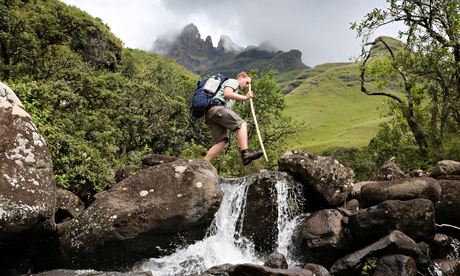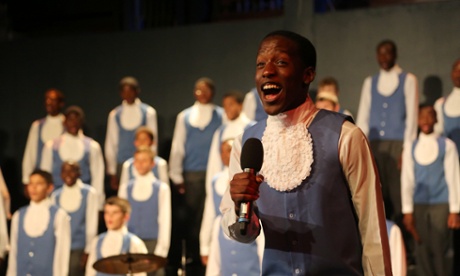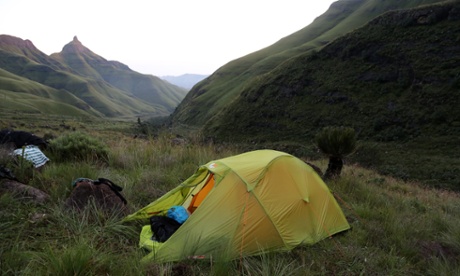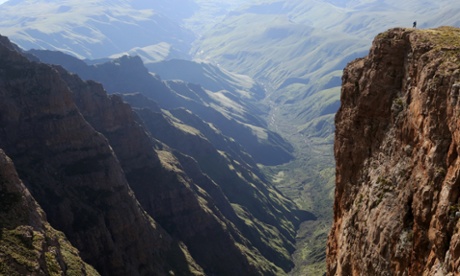
We had everything we needed for a wilderness trek: stove, lightweight tent, food for four days, sleeping bags and whisky. Our sticks were sturdy and our map heavily annotated with local knowledge. We stood on the veranda at the backpackers’ lodge and gazed south. Only one thing was missing: the mountains.
They had been around the previous afternoon when we’d driven to the Drakensberg Boys’ School and watched its famous choir perform. They’d been there later that evening, gloriously golden and impossibly tall, when we sat on the veranda of Inkosana Lodge, soaking up knowledge from local guide and expert Ed Salomons. But now they were gone, replaced by heavy, gushing clouds. We waited, hoping for a break that never came, and eventually set out, leaving our car at Monks Cowl Park HQ and writing our details in the warden’s hut.
“Paths are marked up to Blind Man’s Corner,” said the ranger. “After that, it’s wilderness. No shops, no signposts, no people, no marked trails. Did you book a cave?”

One of the many joys of the Drakensberg is that you can sleep in a cave. The range is really a spectacular 1,000km escarpment dotted with national park offices and entry points to the wilderness. Day trails crisscross the lower slopes, but to reach the peaks, you have to plan on sleeping up there, hence the use of caves. Ed, however, had insisted that a tent was essential: “It can be very disorienting up there. Never rely on finding a cave.”
That first day was tough. My son, Connor, and I slogged up through eternal rain and cloud, seeing nothing for eight hours. After the last signpost, the trail petered out and we were picking our way up the side of a roaring mountain stream. Cycad trees loomed out of the mist, then, quite suddenly, two people: a pair of ragged Lesothans carrying big packs. Ed had told us: “You probably won’t see anyone, but if you do, they’ll be dope smugglers.”
Eventually, we decided we’d reached our campsite. The ground was steep and rocky but there was a tent-sized patch beside a fallen cycad. We were both soaked to the skin and shaking with cold having, foolishly, brought only lightweight waterproofs. Big mistake. The Drakensberg needs the same gear you’d take on a multi-day trek across the Scottish highlands. We cooked in the rain, slugged down a tot of whisky, then dived inside our two-man shelter. It was about 7pm. Neither of us dared mention what we were thinking: “What if this rain keeps going? Shall we just give up?”

I woke in the darkness and lay listening. A jackal was yelping far down the valley, but it was the absence of rain drumming on the tent that had woken me. I clambered outside. The night had completely cleared, revealing a vast panorama of stars, but more breathtaking were the monumental peaks, great soaring giants of rock that blotted out whole segments of the sky. It was our first intimation of why the Berg is an irresistible attraction to South African backwoods trekkers.
We were up again at dawn, watching the sun light the ridges then inch its way down towards us and finally, blissfully, start warming us up. By then we were already on the move, walking steeply upwards towards a distant notch in the vast wall of cliffs to our right. The two-mile climb to the 3,000m pass took most of the morning. Along the way we stopped to inspect the many flowers – the Drakensberg boasts an incredible 350 endemic plant species, but saw no animals at all. One reason this is a great African trekking area is its lack of dangerous wildlife (snakes the only exception).
At last we scrambled up a narrow stony gulch and emerged in a low grassy valley flanked by scars of rock. The wind was cold now and we were eager to find Inkosana cave, something that proved extremely difficult. Eventually, however, after an hour of checking various rocky outcrops, we stumbled on a low cavern that looked as though it had been used by humans. It was also being used by a mountain stream as a short cut. We set the tent up outside and clambered up to the ridge behind to watch the bearded vultures far below, appearing and disappearing in the thick clouds that were welling up the cliff face. Totally alone and without any link to the world below, we were tiny specks in an uncompromising kingdom of verticals.

Dawn came with a thick covering of cloud, but there was no time to delay. Ed had been emphatic that we must be walking by sunrise. “Get on the ridge – that’s the Lesotho border – and head along till you find a sudden dip. Turn left and follow that to the head of the Ship’s Prow Pass, where you’ll go down. It’ll take you all day. Boulders, river, bushes, snakes – lots of bundu-bashing.”
The sky was clearing when we hit the dip Ed had described and soon we had spectacular views down the 1,000m cliffs and across various bergs. Now a thin, unreliable trail emerged and we followed it steeply down. A gang of baboons watched our progress intently, screaming the occasional warning. We stopped to watch them, and at that moment, with a rush of wings, a black eagle swept in and grabbed one of the babies. The baboons scattered and within a minute all was silent again.
Now our day became tougher. As we hit the lower valley, the path vanished, the cliff walls closed in and we were forced to crisscross the ever-stronger river, wading waist-deep in cold water. Twice we stopped to make tea: once in a clump of flowering protea trees where malachite sunbirds were dancing from bloom to bloom in greedy glee; and once by a waterfall, where I drank deeply, wishing we could stop for the night. A river bed in the mountains, however, is no place to make camp. (The water is drinkable everywhere in the Berg, as clear and delicious as any you could ever taste.)
Ten hours after leaving the ridge we finally left the valley, taking a gentle, grassy path over the shoulder of a hill and camping in splendid isolation with a view across miles and miles of misty mountains and ridges. In the morning we were greeted by a herd of eland wandering past, then came rheboks and baboons, who kept well clear as we packed for the long descent back to civilisation.
In a world of sanitised travel, this trek felt like an unforgettable Technicolor extravaganza of genuine experience. Mind you, the first can of soft drink back at Park HQ was heaven too.
• Flights were provided by South African Airways (0844 375 9680, flysaa.com). Accommodation was provided by Inkosana Lodge, which has dorm beds from R175 (£10) a night and thatched rondavels from £21 for two. There’s an outdoor swimming hole, gardens, meals for about £5 and a self-catering kitchen. More information from drakensbergbackpackers.com. Campsites can be booked at kznwildlife.com and at park offices. The Ukhahlamba-Drakensberg park publishes six maps covering the entire range. We used number two: Cathedral Peak (ISBN 978-3-941602-19-9)







